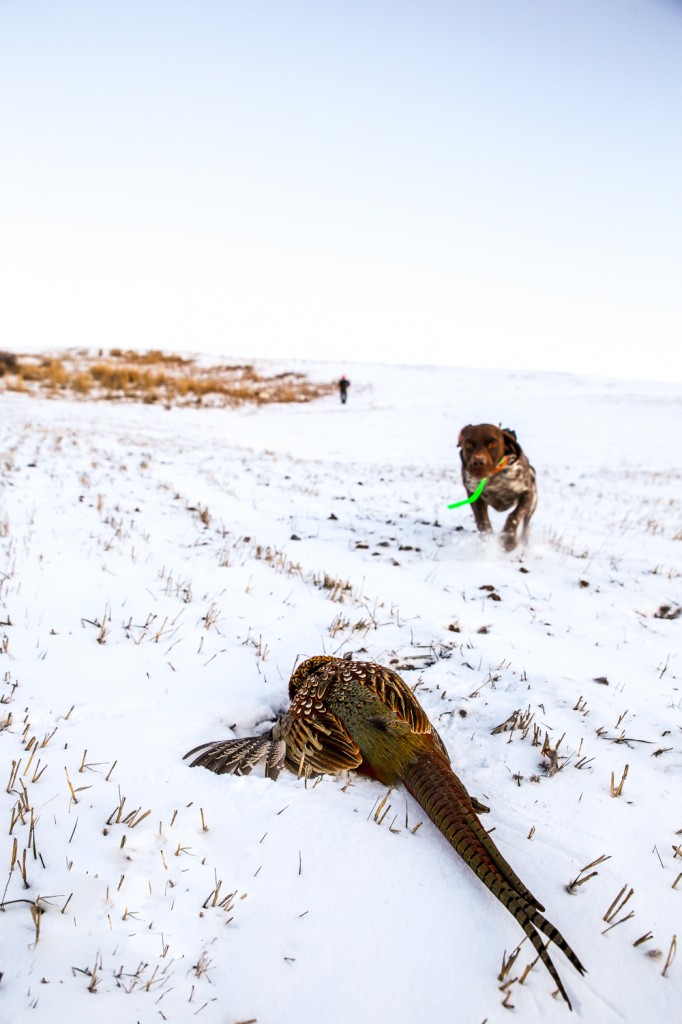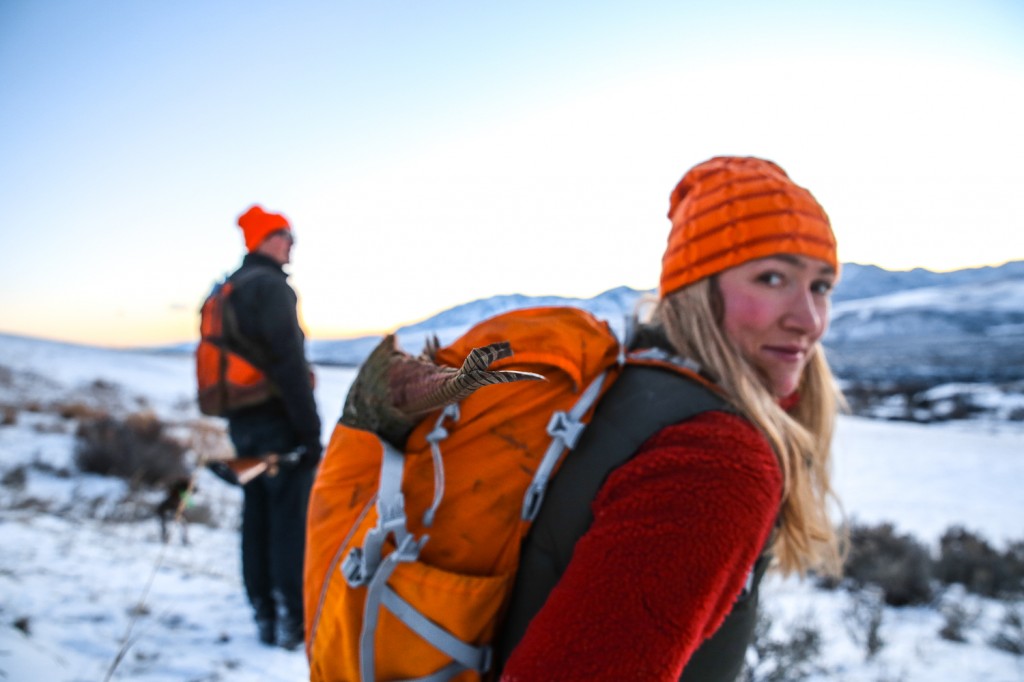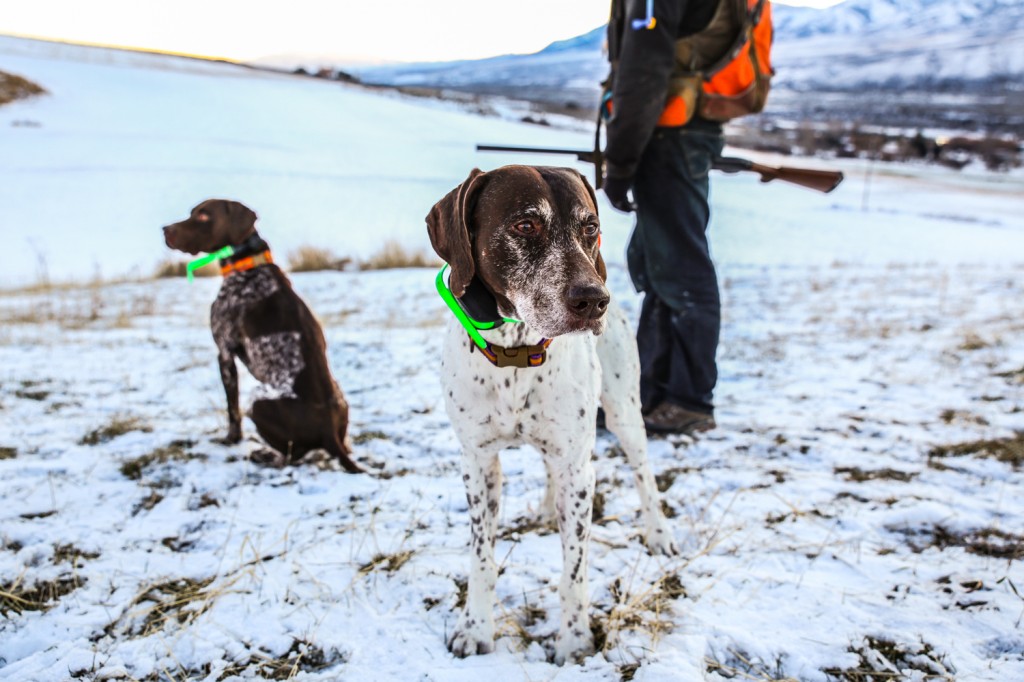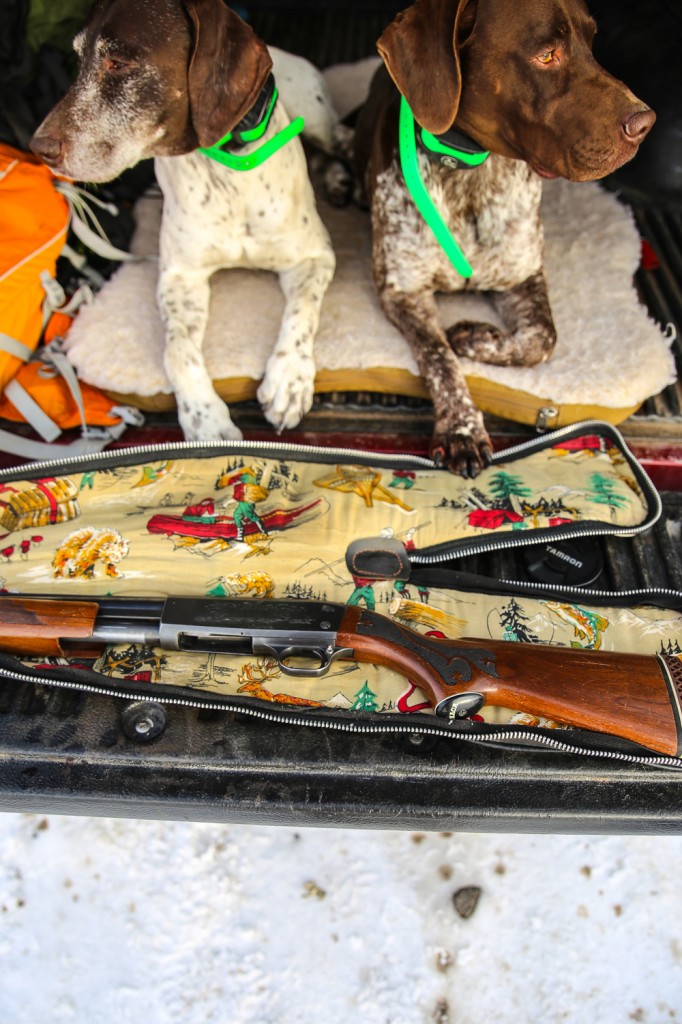Farley is locked up on a staunch point, frozen in place with his head turned back over his shoulder, his nostrils flaring, his eyes shining in the cold. I line up his point by following the direction of his nose and eyes to the base of a scraggly brush; there, where the roots form an abstracted cage against the earth, I see a pheasant dressed in drab greys and browns. I relax and step forward through the snow, shotgun idle in my right hand now turning numb with cold, I kick the bottom of the bush with my boot and call out to Robbie, “Hen!” So he’ll know to not shoot.
The hen rises up out of the snow, twigs and grey of winter on broad, thumping wings. I feel the wind of her flight on my face. We watch her as she goes deeper into the night where it grows in the East.
Farley looks at me like I’ve betrayed him. I tell him, “That’s a hen, big boy. No bird. Get on.” He blinks at me once, turns on his heels, and heads off into the brush and thicket at a gentle but determined jog — a gait he has spent ten years developing, a pace he can hold for hours on end. He heads out into a blaze of winter white blended with hay stubble that buzzes in an adamant breeze. He heads out into the exotic scent of rooster on the wind, into the dream that every bird dog dreams; to run, to sniff, to catch scent, to point, to wait for the shot, to retrieve, to give the game to the master, to be thumped on the arse by the palm of a gloved hand and told, “Good boy. Good work.“
We are on a ranch that belongs to our friends; every curve of the earth here speaks of legacy. The land rises up in good natured swoops and is strung together by wisps of brush that serve to fortify the drainages cut into stone by mountain water. Bunches of thorns and brambles give way to scrub aspen and sagebrush and it is in the broadness of these places that the pheasant can be found. This is a thriving and wild population of birds, an even mixture of hen and rooster, tail feathers here grow long and graceful, and the birds are fat on wild forage.
It is snowy. We track pheasant through the snow, their footprints are are easy to spot and almost Jurassic in nature compared to the other upland birds we hut. We monitor the dogs as they work, breathe out our cold smoke into the warm gleam of the sunset and trudge, step by step, upwards, paying attention to the body language of the pups as they quarter the space before us.
Pheasant are runners, they will run to eternity and beyond; flying is a last resort. The dogs catch scent, move cautiously, wait tentatively with their noses pointed into the wind, creep forward, relocate, and then break into an easy trot again. We walk quickly, keeping up is vital, no working dog should work in vain.

 I can feel the wind gusts brushing my face rosy, I shift my gun back and forth in my hands as I try to keep feeling in my fingers. It is a cold night to hunt, the sun has slipped away and the air is fading to blue, chilling itself further as it passes over snow and ice. We have been walking for a while, my body feels warm but there is an insidious tingling in my toes no matter how fast I move or how much I stomp my feet. I tuck my chin down into my coat layers, as I always do, squint, try to wet my stony eyeballs with warmth by blinking too many times, and feel my exhalation turn to fine crystal on the curves of my cheekbones.
I can feel the wind gusts brushing my face rosy, I shift my gun back and forth in my hands as I try to keep feeling in my fingers. It is a cold night to hunt, the sun has slipped away and the air is fading to blue, chilling itself further as it passes over snow and ice. We have been walking for a while, my body feels warm but there is an insidious tingling in my toes no matter how fast I move or how much I stomp my feet. I tuck my chin down into my coat layers, as I always do, squint, try to wet my stony eyeballs with warmth by blinking too many times, and feel my exhalation turn to fine crystal on the curves of my cheekbones.
I am working closely with Farley while Robert keeps tabs on Tater Tot. I always feel lucky to be partnered with our white dog; Farley is an expert. When I say expert, I mean a master hunter. His bird repertoire is as extensive as the interior West allows and includes some waterfowl; he is a true utility gun dog and the envy of many of our friends. He knows how to respectively work every species bird he hunts, how hard he can push them, what to expect of them behaviorally and what their preferred cover looks like. Some people say pheasant cannot be properly hunted by a pointer but if they had the great pleasure of hunting behind Farley, they would be forced to adopt a different opinion on the mater. Farley doesn’t believe in wasting time. He is efficient, right down to the speed at which he carefully covers ground. He is a patient teacher, I learn from him every time we work together.
Tater Tot, on the other hand, is a young dog. Pheasant are hard on him. He has been raised on chukar and Hungarian partridge in big, wide open country which is perfect for a dog that runs huge. Any bird we hunt in thick brush results in him making some mistakes. He’ll learn, he’ll get better, it’s a matter of him working on his ten thousand hours and perfecting his craft. With that in mind, Tater Tot teaches me, too, every single time we go out. I learn from his mistakes and his successes.
I watch our dogs develop their craft and I learn to be patient with myself when it comes to developing my own craft, when it comes to building my gifts and honing my talents. I remember that developing a voice within the realm of creative work can take a lifetime of evolution. I realize that learning about myself enough to be proficient at expressing myself is honest work I can afford to be tenacious about; it is work that is worth the work.
Having an incredible bird dog isn’t just about bloodlines (though, those do help), it’s about exposure and development of natural instinct, it’s about taking my pup out and getting him into big country where he can work his heart out, rise to his full potential and develop a sturdy foundation for his skill set. From time to time, Tater is going to bust coveys, run over singles, approach birds from the wrong direction and suffer moments of impatience and occasionally he might lose all all self-control and gallop around like a buckaroo.
He will lock up on exquisite, unexpected points on tight holding birds and will look as majestic as anything; he will have moments wherein he is god of all the dogs. He will have good luck. He will have bad luck. There will be days when he rules the world on his four fleet feet and his humans will fail to get him his bird. But in all of that success and failure and learning, he’ll be working steadily on his craft until one day, we’ll cast him off into the sagebrush and rim rock to do his work and realize that he, too, has become a master of his craft.
I hope I can say the same of myself someday. Until then, there are those wily old pheasants running fast through the snow, tails streaming behind them like comets, and our little brown pup going forth earnestly and courageously into the winter white.






